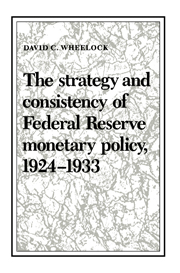Book contents
- Frontmatter
- Contents
- List of Figures
- List of Tables
- Preface
- 1 Introduction
- 2 The objectives of monetary policy, 1924–1933
- 3 Member-bank borrowing and the Fed's policy strategy
- 4 Policy disagreements within the Federal Reserve System: the effects of institutional change
- 5 Conclusion
- Appendix: Variable definitions and data sources
- References
- Index
3 - Member-bank borrowing and the Fed's policy strategy
Published online by Cambridge University Press: 11 September 2009
- Frontmatter
- Contents
- List of Figures
- List of Tables
- Preface
- 1 Introduction
- 2 The objectives of monetary policy, 1924–1933
- 3 Member-bank borrowing and the Fed's policy strategy
- 4 Policy disagreements within the Federal Reserve System: the effects of institutional change
- 5 Conclusion
- Appendix: Variable definitions and data sources
- References
- Index
Summary
The influence of the reserve banks upon the volume of credit is … felt not directly, but indirectly through the member banks. The reserve banks do not “push” credit into use.
Benjamin Strong (United States House of Representatives 1926, p. 468)The Federal Reserve used its policy tools, especially open-market operations in government securities, less aggressively during the Great Depression than it had from 1924 to 1929. This change in responsiveness could have come from a fundamental change in policy strategy, perhaps resulting from the death of Benjamin Strong in 1928 and the subsequent reorganization of the Open Market Committee. Or, the Fed's actions during the depression might in fact have been consistent with the goals and methods it employed during the 1920s.
The Federal Reserve believed that it could achieve its objectives by influencing the cost and availability of bank credit. Open-market operations affected the extent of member-bank borrowing from the Fed, which System officials believed had a direct impact on market interest rates. Open-market purchases provided reserves that permitted a reduction in member-bank borrowing and led to generally easier credit conditions. Open-market sales withdrew reserves, created a reserve need which banks satisfied by increasing their borrowing, and led to higher interest rates. In general the Fed did not specify quantity targets for borrowed reserves or interest rates, but watched each closely as indicators of monetary conditions.
- Type
- Chapter
- Information
- Publisher: Cambridge University PressPrint publication year: 1991

